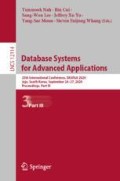Abstract
State-of-the-art approaches in the field of neural-embedding models (NEMs) enable progress in the automatic extraction and prediction of semantic relations between important entities like active substances, diseases, and genes. In particular, the prediction property is making them valuable for important research-related tasks such as hypothesis generation and drug-repositioning. A core challenge in the biomedical domain is to have interpretable semantics from NEMs that can distinguish, for instance, between the following two situations: a) drug \( x \) induces disease \( y \) and b) drug \( x \) treats disease \( y \). However, NEMs alone cannot distinguish between associations such as treats or induces. Is it possible to develop a model to learn a latent representation from the NEMs capable of such disambiguation? To what extent do we need domain knowledge to succeed in the task? In this paper, we answer both questions and show that our proposed approach not only succeeds in the disambiguation task but also advances current growing research efforts to find real predictions using a sophisticated retrospective analysis.
Access this chapter
Tax calculation will be finalised at checkout
Purchases are for personal use only
Notes
- 1.
- 2.
- 3.
- 4.
- 5.
- 6.
- 7.
- 8.
References
Gefen, D., et al.: Identifying patterns in medical records through latent semantic analysis. Commun. ACM 61(6), 72–77 (2018)
Chiu, B., Crichton, G., Korhonen, A., Pyysalo, S.: How to train good word embeddings for biomedical NLP. In: Proceedings of the 15th Workshop on Biomedical Natural Language Processing, pp. 166–174, 2016 August
Chiang, A.P., Butte, A.J.: Systematic evaluation of drug–disease relationships to identify leads for novel drug uses. Clin. Pharmacol. Ther. 86(5), 507–510 (2009)
Herskovic, J.R., Tanaka, L.Y., Hersh, W., Bernstam, E.V.: A day in the life of PubMed: analysis of a typical day’s query log. J. Am. Med. Inform. Assoc. 14(2), 212–220 (2007)
Larsen, P.O., Von Ins, M.: The rate of growth in scientific publication and the decline in coverage provided by Science Citation Index. Scientometrics 84(3), 575–603 (2010)
Baroni, M., Dinu, G., Kruszewski, G.: Don’t count, predict! a systematic comparison of context-counting vs. context-predicting semantic vectors. In: Proceedings of the 52nd Annual Meeting of the Association for Computational Linguistics (Volume 1: Long Papers), vol. 1, pp. 238–247 (2014)
Gottlieb, A., Stein, G.Y., Ruppin, E., Sharan, R.: PREDICT: a method for inferring novel drug indications with application to personalized medicine. Mol. Syst. Biol. 7(1), 496 (2011)
Zhang, W., et al.: Predicting drug-disease associations based on the known association bipartite network. In: 2017 IEEE International Conference on Bioinformatics and Biomedicine (BIBM), pp. 503–509. IEEE, 2017 November
Tshitoyan, V., et al.: Unsupervised word embeddings capture latent knowledge from materials science literature. Nature 571(7763), 95 (2019)
Agarwal, P., Searls, D.B.: Can literature analysis identify innovation drivers in drug discovery? Nat. Rev. Drug Disc. 8(11), 865 (2009)
Mikolov, T., Chen, K., Corrado, G., Dean, J.: Efficient estimation of word representations in vector space. arXiv preprint arXiv:1301.3781 (2013)
Dudley, J.T., Deshpande, T., Butte, A.J.: Exploiting drug–disease relationships for computational drug repositioning. Brief. Bioinf. 12(4), 303–311 (2011)
Lev, G., Klein, B., Wolf, L.: In defense of word embedding for generic text representation. In: Biemann, C., Handschuh, S., Freitas, A., Meziane, F., Métais, E. (eds.) NLDB 2015. LNCS, vol. 9103, pp. 35–50. Springer, Cham (2015). https://doi.org/10.1007/978-3-319-19581-0_3
Keiser, M.J., et al.: Predicting new molecular targets for known drugs. Nature 462(7270), 175 (2009)
Lotfi Shahreza, M., Ghadiri, N., Mousavi, S.R., Varshosaz, J., Green, J.R.: A review of network-based approaches to drug repositioning. Brief. Bioinform. 19, 878–892 (2017)
Wawrzinek, J., Balke, W.-T.: Measuring the semantic world – how to map meaning to high-dimensional entity clusters in PubMed? In: Dobreva, M., Hinze, A., Žumer, M. (eds.) ICADL 2018. LNCS, vol. 11279, pp. 15–27. Springer, Cham (2018). https://doi.org/10.1007/978-3-030-04257-8_2
Hill, F., Reichart, R., Korhonen, A.: Simlex-999: evaluating semantic models with (genuine) similarity estimation. Comput. Linguist. 41(4), 665–695 (2015)
Rinaldi, F., Clematide, S., Hafner, S.: Ranking of CTD articles and interactions using the OntoGene pipeline. In: Proceedings of the 2012 BioCreative Workshop, April 2012
Jensen, L.J., Saric, J., Bork, P.: Literature mining for the biologist: from information retrieval to biological discovery. Nat. Rev. Genet. 7(2), 119 (2006)
Mikolov, T., Yih, W.T., Zweig, G.: Linguistic regularities in continuous space word representations. In: Proceedings of the 2013 Conference of the North American Chapter of the Association for Computational Linguistics: Human Language Technologies, pp. 746–751 (2013)
Wick, Christoph: Deep Learning. Nature 521(7553), 436–444 (2016). MIT Press, 800
Kingma, D.P., Ba, J.: Adam: a method for stochastic optimization. CoRR. abs/1412.6980 (2014)
Hinton, G.E., et al.: Improving neural networks by preventing co-adaptation of feature detectors (2012)
Patrick, M.T., et al.: Drug repurposing prediction for immune-mediated cutaneous diseases using a word-embedding–based machine learning approach. J. Invest. Dermatol. 139(3), 683–691 (2019)
Author information
Authors and Affiliations
Corresponding author
Editor information
Editors and Affiliations
Rights and permissions
Copyright information
© 2020 Springer Nature Switzerland AG
About this paper
Cite this paper
Wawrzinek, J., Pinto, J.M.G., Wiehr, O., Balke, WT. (2020). Semantic Disambiguation of Embedded Drug-Disease Associations Using Semantically Enriched Deep-Learning Approaches. In: Nah, Y., Cui, B., Lee, SW., Yu, J.X., Moon, YS., Whang, S.E. (eds) Database Systems for Advanced Applications. DASFAA 2020. Lecture Notes in Computer Science(), vol 12114. Springer, Cham. https://doi.org/10.1007/978-3-030-59419-0_30
Download citation
DOI: https://doi.org/10.1007/978-3-030-59419-0_30
Published:
Publisher Name: Springer, Cham
Print ISBN: 978-3-030-59418-3
Online ISBN: 978-3-030-59419-0
eBook Packages: Computer ScienceComputer Science (R0)

